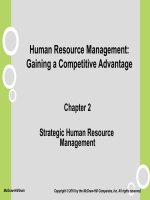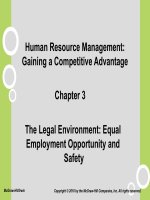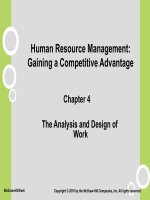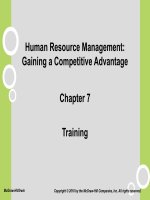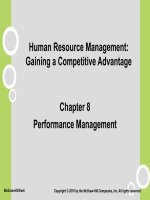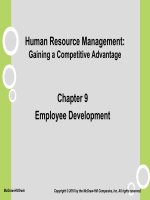HRM gaining a competitive advantage noe ch001
Bạn đang xem bản rút gọn của tài liệu. Xem và tải ngay bản đầy đủ của tài liệu tại đây (215.95 KB, 35 trang )
Human Resource Management:
Gaining a Competitive Advantage
Chapter 1
Human Resource Management:
Gaining a Competitive
Advantage
McGraw-Hill/Irwin
Copyright © 2010 by the McGraw-Hill Companies, Inc. All rights reserved.
Learning Objectives
• Discuss roles and activities of a company’s HRM function
• Discuss implications of the economy, makeup of the labor
force, and ethics for company sustainability
• Discuss how HRM affects a company’s balanced scorecard
• Discuss what companies should do to compete in the
global marketplace
• Identify the characteristics of the workforce and how they
influence HRM
• Discuss HRM practices that support high-performance
work systems
• Provide a brief description of HRM practices
1-2
Introduction
• Competitiveness – a company’s
ability to maintain and gain market
share
• Human resource management –
the policies, practices, and systems
that influence employees’ behavior,
attitudes, and performance
1-3
.
Human Resource Management Practices
1-4
Responsibilities of HR Departments
1.
2.
3.
4.
5.
6.
7.
8.
9.
Employment and Recruiting
Training and Development
Compensation
Benefits
Employee Services
Employee and Community Relations
Personnel Records
Health and Safety
Strategic Planning
1-5
HR as a Business with 3 Product Lines
Business
Partner
Services
Administrative
Services and
Transactions
Strategic Partner
Human
Resources
1-6
6 Competencies for the HR Profession
1-7
How is the HRM Function Changing?
Time spent on administrative tasks is decreasing.
HR roles as a strategic business partner, change
agent, and employee advocate are increasing.
HR managers are challenged to shift focus from
current operations to future strategies and prepare
non-HR managers to develop and implement HR
practices.
This shift presents two important challenges:
– Self-service – giving employees online access to
information about HR issues
– Outsourcing – the practice of having another
company provide services to save money and spend
more time on strategic business issues.
1-8
Questions Used to Determine If Human Resources
Are Playing a Strategic Role in the Business
1. What is HR doing to provide value-added services to internal clients?
2. What can the HR department add to the bottom line?
3. How are you measuring the effectiveness of HR?
4. How can we reinvest in employees?
5. What HR strategy will we use to get the business from point A to point B?
6. What makes an employee want to stay at our company?
7. How are we going to invest in HR so that we have a better HR
department than our competitors?
8. From an HR perspective, what should we be doing to improve our
marketplace position?
9. What’s the best change we can make to prepare for the future?
1-9
How is the HRM Function Changing?
• As part of its strategic role, one of the key
contributions that HR can make is to
engage in evidence-based HR.
• Evidence-based HR – demonstrating
that human resource practices have a
positive influence on the company’s
bottom line or key stakeholders.
1-10
The HRM Profession
• HR salaries vary depending on education
and experience as well as the type of
industry
• The primary professional organization for
HRM is the Society for Human
Resource Management (SHRM)
1-11
3 Competitive Challenges
Influencing HRM
Technology
Sustainability
Global
1-12
The Sustainability Challenge
• Sustainability refers to the ability of a
company to survive and succeed in a
dynamic competitive environment.
• Stakeholders refers to shareholders, the
community, customers, and all other
parties that have an interest in seeing that
the company succeeds
1-13
The Sustainability Challenge
Sustainability includes the ability to:
• provide a return to shareholders
• provide high-quality products, services and
work experiences for employees
• increase value placed on intangible assets
and human capital
• social responsibility
– Adapt to changing characteristics and expectations of
the labor force
– Address legal and ethical issues
– Effectively use new work arrangements
1-14
The Sustainability Challenge
The changing structure of the economy
Skill demands for jobs are changing
Knowledge is becoming more valuable
– Intangible assets -- human capital, customer
capital, social capital, and intellectual capital
– Knowledge workers – employees who
contribute to the company through a specialized
body of knowledge
– Empowerment – giving employees
responsibility and authority to make decisions
regarding all aspects of product development or
customer service
Learning organization
1-15
The Sustainability Challenge
2 Changes in Employment Expectations:
1. Psychological Contract
2. Alternative Work Arrangements
1-16
Concerns with Employee Engagement
Employee engagement - degree to which employees are fully
involved in their work and strength of their commitment.
10 Common Themes of Employee Engagement
1
2
3
4
5
6
7
8
9
10
Pride in employer
Satisfaction with employer
Satisfaction with the job
Opportunity to perform challenging work
Recognition and positive feedback from contributions
Personal support from manager
Effort above and beyond the minimum
Understanding the link between one’s job and the company’s mission
Prospects for future growth with the company
Intention to stay with the company
1-17
The Balanced Scorecard
• The balanced scorecard gives managers the
opportunity to look at the company from the
perspective of internal and external customers,
employees and shareholders.
• The balanced scorecard should be used to:
– Link human resource management activities to the
company’s business strategy.
– Evaluate the extent to which the human resource
function is helping the company’s meet it’s
strategic objectives.
1-18
The Balanced Scorecard
How do customers see us?
What must we excel at?
Can we continuously improve and
create value?
How do we look to shareholders?
1-19
Customer Service and Quality
Total Quality Management (TQM)
Core values of TQM include:
• Methods and processes are designed to meet internal
and external customers’ needs.
• Every employee receives training in quality.
• Promote cooperation with vendors, suppliers, and
customers.
• Managers measure progress with feedback based on
data.
• Quality is designed into a product or service so that
errors are prevented from occurring rather than being
detected and corrected.
1-20
Customer Service and Quality Emphasis
Malcolm Baldrige National Quality Award
ISO 9000:2000
Six Sigma Process
Lean Thinking
1-21
Changing Demographics
Workforce Diversity
• Internal labor force is the labor force of
current employees
• External labor market includes persons
actively seeking employment
• U.S. workforce is aging rapidly
• Increased Workforce Diversity
• Influence of Immigration
1-22
Managing a Diverse Workforce
To successfully manage a diverse workforce, managers
must develop a new set of skills including:
Communicate, coach and develop employees from a
variety of backgrounds
Provide performance feedback that is based on objective
outcomes
Create a work environment that makes it comfortable for
employees of all backgrounds to be creative and
innovative.
Recognize and respond to generational issues.
1-23
Legal and Ethical Issues
5 areas of the legal environment that have
influenced HRM over the past 25 years:
1.
2.
3.
4.
5.
Equal employment opportunity legislation
Employee safety and health
Employee pay and benefits
Employee privacy
Job security
Women and minorities still face the “glass ceiling”
Sarbanes-Oxley Act of 2002
1-24
Legal and Ethical Issues
Ethics - the fundamental principles by which
employees and companies interact
Ethical HR practices:
HRM practices must result in the greatest good for the
largest number of people
Employment practices must respect basic human rights
of privacy, due process, consent, and free speech
Managers must treat employees and customers
equitably and fairly
1-25

